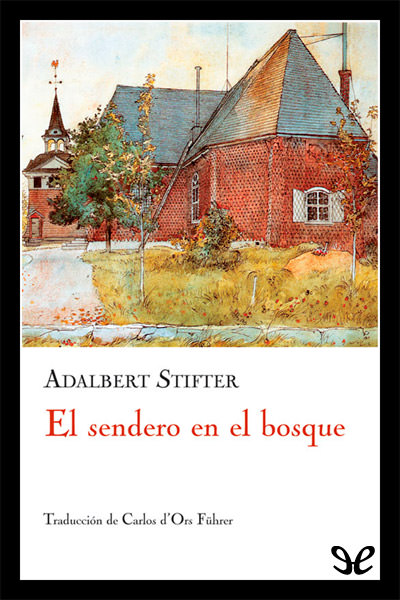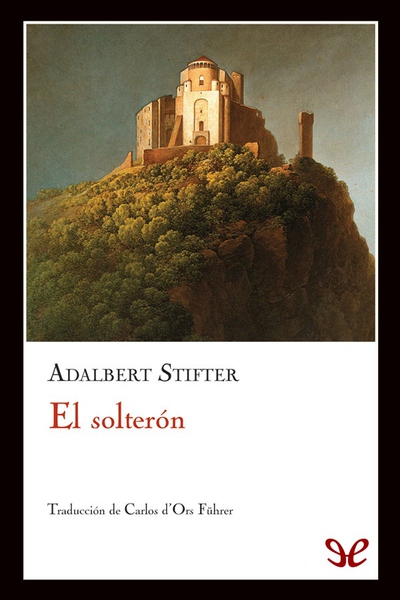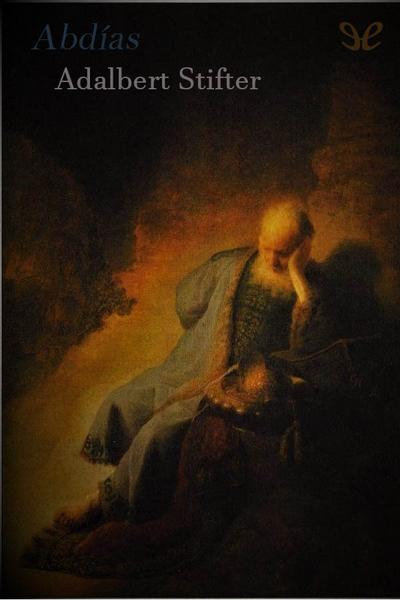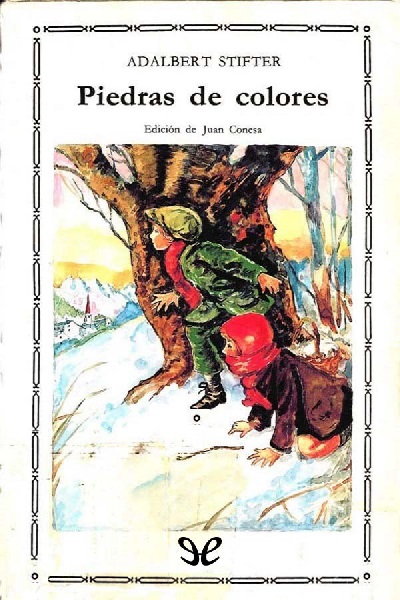oleebook.com
Pietre colorate de Adalbert Stifter
de Adalbert Stifter - Género: Italian
Sinopsis
Lavvincente racconto di una violenta epidemia di peste (Granito), la vicenda «piena di pacato ardimento» (Th. Mann) di un eroico sacerdote (Pietra calcarea), gli arcani destini di una fanciulla disgraziata (Tormalina), le prodigiose avventure di due fratellini (Cristallo di rocca), la commovente storia di una grande amicizia (Mica), una storia damore sullo sfondo delle guerre napoleoniche (Calcite): con il titolo Pietre colorate lo scrittore austriaco Adalbert Stifter pubblica nel 1853 sei novelle e a ciascuna di esse decide di dare come titolo appunto il nome di una pietra.
Frutto di un progetto protrattosi per oltre dieci anni, la raccolta, originariamente pensata come dilettevole letteratura per linfanzia, si è trasformata col tempo nel documento poetico di una severa condanna da parte di Stifter nei confronti della esasperata funzionalizzazione della società urbana, dei suoi ritmi frenetici e disumani. Partiti per essere i destinatari di queste storie, i bambini ne sono divenuti invece i protagonisti, autentici portavoce di un universo intatto che lautore vuole opporre al mondo moderno, di cui avverte linsensatezza e limmoralità. Accanto a questi inconsapevoli messaggeri di purezza troneggia in Pietre colorate una Natura grandiosa e imperscrutabile con la quale gli esseri umani sono chiamati a misurarsi, dando prova di modestia e solidarietà. Esito più completo e più maturo dello Stifter novellista negli anni seguenti lo scrittore si cimenterà in Nachsommer e in Witiko con la complessa forma del romanzo Pietre colorate è da considerarsi una autentica vetta della novellistica ottocentesca e forse il capolavoro di un grande scrittore che sia pur con ritardo in questi anni la cultura italiana va giustamente riscoprendo.
Descargar
Descargar Pietre colorate ePub GratisLibros Recomendados - Relacionados
Reseñas Varias sobre este libro
As Adalbert Stifter belonged to the Biedermeier period he habitually depicted life conflictless and almost idyllic but due to originality of the plots and their cordiality his tales are quite remarkable.
All the stories in Motley Stones directly or obliquely concern children.
Granite is about wagon grease in the present and an outbreak of deadly plague in the past
Would you to have your feet greased?
Having always regarded the man as a great curiosity, I felt honored by his familiar manner, and held out both my feet. He dipped his spoon into the hole and went to work, laying one slow stroke on each of my feet. The liquid spread beautifully on the skin, extraordinarily clear and golden brown, and sent up its pleasant resinous fragrance.
Limestone is about a poor and rigorously ascetic pastor who always tried to protect local children from the wrath of nature
he went to the holy water stoup that hung beneath the beautifully carved little crucifix, sprinkled himself with the water, and left the room.
By the light of my candle I saw him lie down on the wooden bench in the shallow niche in the spacious vestibule, and place the Bible under his head as a pillow.
Tourmaline is about kindness and a peculiar orphaned girl
I was walking along the wide sidewalk, and I saw a raven sitting on the pavement. He wasnt afraid, it seemed he couldnt fly, and he walked along ahead of me when I followed him. I bent down, talked to him, reached for him, and he let me pick him up. Mother, I didnt hurt him, I only petted him. Then a horribly big face looked out of the basement window of the Perron House and cried: Stop, stop.
I looked over at the head, its eyes stared, it was very pale, and terribly big. I let the raven go, stood up, and ran home. Mother, I really didnt hurt him, I only wanted to pet him.
In Rock Crystal two siblings are lost high in the mountains on Christmas Eve
After a time they saw crags. They loomed up dark and indistinct from the white and opaque light. As the children approached, they nearly ran into them. The crags rose a wall, completely perpendicular, so that barely a snowflake could cling to their sides.
Cat-Silver meaning tiny mother-of-pearl flakes is about a mysterious swarthy girl, the terrible hailstorm and the conflagration
The leaves were beaten down, the twigs were beaten down, the boughs were broken off, the grass was furrowed as though iron spikes had harrowed it. The hailstones were large enough to kill a grown person.
Rock Milk is about the dwellers in the castle and the Napoleonic wars
When all had made themselves comfortable, when the two youngest children had fallen asleep, and the two oldest had huddled together near their mother by the stove, and the spinning wheels were purring, they fell to telling tales again, but today with great zeal they told tales of the war, each in the hues lent by their separate passions.
When humans abide by cordiality and not by cruelty there are peace and harmony.132 s S?e?a?n?895 455 Shelved as 'sampled'
Had to return this early to the library because apparently someone else in my fair city was jonesing to read some Stifter, as translated by the stellar Isabel Fargo Cole, of Wolfgang Hilbig translation fame. So I read about 2 2/3 of the novellas collected here, having to skim the last third or so of 'Tourmaline' to my chagrin, as it had captivated me more than the others did. The other two I read were 'Granite' (not bad, probably about a three-star read) and 'Rock Crystal,' also previously published by NYRB. I'd been interested in reading the latter for years after reading various friends' here and there, and perhaps built it up too much in my head. It certainly kept my interest, but maybe I just wasn't in the mood for Stifter's style. I very much would have d to finish the entire book, but I'm having enough trouble finishing books on my own even without other library users cutting short my allotted lending period.2021 mist nyrb14 s J.M. HushourAuthor 6 books226
I read Stifter's Rock Crystal a couple of years ago and really enjoyed it, but I didn't realize it was actually a mere 1/6 of a larger work, presented here in its totality for what might be its first time in English.
Stifter was an Austrian writer whose life spanned basically Napoleon-to-Bismarck, so the most interesting parts of the Germanic world's long 19th century. However, he shies away from the usual tropes of the time and instead writes quiet and often weird little stories, the "motley stones" of his title. These are steeped in a sadly lost kind of grimm or rural-gothic aesthetic that I cherish. Think Caspar David Friedrich's paintings or maybe the album The Black Rider by Tom Waits and you'll know what I'm talking about. Stifter is more subtle though, letting the darkness simply lie in wait while his characters, mostly children, wander about the hills and dales.
Each story here has a stone as its title.
"Granite": a boy and his grandfather walk the mountains while the old man recounts stories of kids surviving the plague. "Limestone": a land surveyor keeps meeting a mysterious, forlorn pastor in the hills. "Tourmaline": a wealthy man and his daughter vanish into the countryside after his wife has an affair with an actor. "Rock Silver" I reviewed elsewhere, about two kids lost in a blizzard on Christmas Eve. "Cat-Silver": three kids in their manor in the country for the summer start encountering a wild little girl who saves them during a hailstorm. "Rock Milk": a crazy rich midget and his steward, with the latter's family, get accosted by white-cloaked soldiers during the night.
They're all excellent, beautiful, little curious things, hence the title, as Stifter explains in his Intro rebuffing his critics.12 s Yuri Sharon243 23
An anthology of six stories, one of which, Rock Crystal, I read several years ago. The others here are as good, or close to such, as that. The first two are shorter and perchance slighter works, but the two longest stories, Limestone and, in particular, Cat-Silver, are impressive. That said, it has to be acknowledged that Stifter is not to everyones taste. Some may find the pace of his step-by-step prose a bit tedious, but once you acquire a taste he is very rewarding. I would say that anyone who enjoys Robert Walser will also enjoy Stifter.fiction9 s sigurd204 34
non immaginavo che dentro le pagine di questo libro si nascondesse il capolavoro che cercavo da tempo. sono sei storie semplici (la prefazione è il manifesto estetico di Stifter) e il modo di guardare queste storie è, come ha detto citati, attraverso due figure simboliche: da una parte c'è un viandante che con bastone e sacco del pellegrino esplora le colline e le montagne, dà un nome agli alberi, insegna a un bambino i nomi delle piante e dei paesaggi; dall'altra parte, c'è un uomo seduto su di una antichissima pietra colorata, immobile. Entrambi hanno lo stesso sguardo: uno sguardo che guarda l'indefinito, soffermandosi qui e là, e rischiarando con la luce intensissima della narrazione di stifter il significato di un oggetto o di un ricordo. Dovunque guarda, però, il viandante contempla la Legge di Dio. Il sommarsi di gesti piccoli e insignificante e le grandi catastrofi del tempo. Tutta ha un suo equilibrio in questo mondo di incanto, eppure c'è qualcosa che incancrenisce quello sguardo, una sottile malinconia che è come una foschia davanti ai suoi occhi; alla maniera di Walser, di Sebald, di Keller, il tono elegiaco di Stifter ci fa capire che qualcosa nel mondo corrode le cose e le proietta nella polvere, ammette con disagio di non far parte di quella realtà "innegabile" di cui fanno parte alberi e pietre; sente la tremenda malinconia del suo essere vano e transitorio.
SEMPLICITÀ
Si apre il cancello del giardino
con la docilità della pagina
che una frequente devozione interroga
e allinterno gli sguardi
non devono fissarsi negli oggetti
che già stanno interamente nella memoria.
Conosco le abitudini e le anime
e quel dialetto di allusioni
che ogni gruppo umano va ordendo.
Non ho bisogno di parlare
né di mentire privilegi;
Bene mi conoscono quelli che mi attorniano,
bene sanno le mie ansie e le mie debolezze.
Ciò è raggiungere il più alto,
quello che forse ci darà il Cielo:
non ammirazioni, né vittorie
ma semplicemente essere ammessi
come parte di una realtà innegabile,
come le pietre e gli alberi.
JLB9 s BJ162 120
Motley Stones, a self-described assortment of fancies for young hearts first published in German in 1853, but translated and published in English for the first time this year, is a very strange book. Its six stories revolve around children and their families, but although you can tell that Stifter is trying, quite hard at times, to be sentimental, even to moralizein that, and that alone, he mostly fails. And although only one story, Tourmaline, is nakedly dark, the darkness is never far from the surface.
Stifter is acutely attuned to nature and landscape, to the way that the world itself changes scale to match the human dramas that give it meaning, now intimate and close, now vast and unknowable. At the same time, he resists the urge to undercut the power and inscrutability of natural forces through personification or domestication.
I suspect that this would be rough going for a reader who wasnt accustomed to the quirks of 19th-century fiction (on top of which Stifter has quite a few quirks all his own). But then again, perhaps not. Cat Silver, my favorite story in this collectionand one of my favorite things Ive read in a long timereminded me of nothing so much as Karin Tidbecks Reindeer Mountain, published a good 150 years later. Both stories are about strange women coming down from mountains. And neither story reminds me all that much of anything else Ive read from the 150-year period that separates them.favorites-read-after-2021 german7 s Chrissie2,811 1,445
SHORT STORIES ARE NOT REALLY MY THING. THERE IS A FAIRY TALE FEEL TP THESE. I LKE BEST THE ONE TITLED GRANIT. THE AITHOR'S DESCRPTIONS OF NATURE ARE WELL DONE. 2023-read austria classics ...more5 s Patricia668 16
The Christmas Eve story, "Rock Crystal" was captivating to read and fun to ruminate on: the green and warm valley and the mountain with its glacier boulders stars and aurora; the way the mountain is dangerous but also holy; and how being lost on the mountain draws out strength and love from all the characters.richandstrange short-stories5 s Adam CantwellAuthor 20 books44
Three point eight four rating on this book reveals that the general reading public is ly mentally unwell. World masterpiece. It's Bolaño but about landscape and housewares. Heavy dread a David Lynch drone, except less airless. With Stifter, you are exposed. i-own4 s Dionysius the Areopagite381 139
WOW
Holy ****, I had no idea this was coming and have been loving Stifter for years. I must have thrown in the towel on the vague hope that more novellas of Kafka's obese friend (who is in my estimation f/w/i/w lightyears beyond, in a single sentence, all of the findings re: Max Brod/trunk) would be charmingly translated, and lo! - - - collected!
Not to mention, this is without question second best book title of the year. I mean I myself have had four books published this year alone... and three of the four must be tied for first place (the other one is really just more formal for the Platonic Dialogue re: Thomism, Flannery O'Connor, et al),
but yeah, aside from 75% of my publications' titles in 2021, this one gets relatively close second.
I always said to myself, if I ever really needed a job and at the same time had a choice in the matter, it would be something NYRB Classics. Books this are cake and point.4 s Brian205 18
And when the oats had vanished at last from the fields, when the hazel bushes lost their color, and the leaves wrinkled and rolled up, when the white patches of stubble on the hills turned brown, when nothing was left in the fields but potatoes cabbage and turnips, when not an apple or a pear was left in the branches of the trees, when even the leaves of those trees were falling, when the flowers that the father had in pots outside the house were taken back into the hothouses, when the blue juniper berries turned bluer and bluer on their bushes, and the green ones swelled and took on a dewy film, when the gossamer spun out again, and the grandmother grew sadder and sadder, and stroked all the children's curls more and more tenderlythey knew that it was time, that they must soon part, gloomy autumn and fog would cover the surroundings, snow and cold would come, and it would be a long time before they could be together. [212]2021 fabulist to-re-read ...more4 s William Patterson45 5
Incredible. I sincerely hope this is the start of a translation trend for Stifter, though I doubt it. Cat Silver has entered my pantheon of favorite stories. All of them are totally unanticipated, radically strange, and completely gripping. There is nothing else quite this writer that I have yet encountered, so I only crave more. If you this, track down Indian Summer if you can 3 s Sylvia525
This was a very enjoyable read. I love folk stories and this book provided me with six wonderful ones, all named after minerals and colorful stones found in the mountains. The titles of the separate story have a deeper meaning when you read the story attached to it.
I love them all, but Rockcrystal is an exceptionally wonderful story for Christmas times. I'm not going to spoil anybody interest by telling the content, read it yourself, enjoy it and I'm sure you're as eager as I'm to buy your own copy. I did!challenge-2012 fairy-tales-legends-myths read-20122 s Rajiv Chopra604 13
I finished this book yesterday and am still wrapping my head around this. On the surface, the books are extremely simple, and some may call them simplistic. The stories have no drama in them. They flow, from the beginning to the end. The stories are about simple folk, living in villages in Germany.
Yet, the stories are captivating, and the descriptions of nature are stunningly beautiful. The stories possess a gentle rhythm, and you must allow yourself to flow with the gentle tide.
Isabel Fargo Cole's translation is, in my view, magnificent. This is a beautiful book and must be on every storyteller's and story lover's bookshelf.
Read one story a day, no more. Then you will savor the beauty of these tales. classics current-fiction1 GaiusVelleius9
Für Freunde gediegener Prosa!1 Ira Therebel711 42
A beautiful collection of 6 short stories by an Austrian author Adalbert Stiftler.
The stories feel folks tales and while there isn't much happening in them they still catch the reader and make them involved in the story. What matters in these stories is the nature. Each is named after a stone and they represent the mood of the story.
It takes place in beautiful Austrian landscapes and their description is absolutely perfect. In Kalkstein we have a landscape that doesn't have much in it, not many trees just a lot emptiness and limestone. It gets well together with the main character who lives a very simple life but has a rich character.
Bergkristal is one of the best stories. The purity and stillness of the snowy landscape where one can't see anything are felt through the whole story and makes one get into the mood of the children experiencing it.
Katzensilber is another one I loved the most. It seems to have most of action in the story and the warmth and brightness of the summer in the nature setting around the grandma's home is also very well felt.
A nice collection with beautiful language and a strongly felt motive of nature and human's place in it.classic-literature fiction german-language ...more1 Tina106 21
Motley Stones is a collection of six tales that (with, perhaps, the exception of the final) feel cozy bedtime stories for adults. With a focus on fine detailing of the pastoral and the slow, often, mundane every day occurrences, these stories feel appropriate for the time of day when you're winding down. Stifter's descriptions of landscapes and the beauty of the natural world are as pleasing as they are fully realized. In another's hands, these passages would bore and drag a narrative, but here, they are oddly compelling.
Even though, as Stifter himself pointed out in the preface, "It was once said against me that I fashion only small things, and that my people are ordinary people," you never feel constrained by the scope of his worlds. You are instead comforted to know and live among his creations. If only for a short time.
4 stars austria short-stories1 Tom1,083
The narrators of these storiesthe motley stonesare several generations removed from their tales, provided as descriptions of persons of remarkable character. Written in the mid-1800s, Stifters tales occur probably around the turn of the 18th century, when Germanic nations were primarily rural, and even the biggest cities were modestly sized by todays standards. Although the natural world is lavishly described throughout, with eyes and insight worthy of Thoreau, Stifter is primarily interested in inflexible eccentricities. Stifters narrators clearly admire these people while also acknowledging that some readers may find them mere fools, while others the narratorsare marked for life by the encounters.
One such example is the nameless, ascetic parson in the story Limestone. (Spoiler alert!) The parson has a secret cause hes been stowing away money forto build, for safety reasons, a new school for the local children. For decades he scrimps and sacrifices, living just above beggary level. Late in the story, after he dies and his will is read, his bequest to the community is revealedas is the fact that his 30+ years of savings isnt nearly enough to cover costs. The well-to-do in the area rise to the occasion and raise the funds necessary to fulfill the requirements of the parsons will.
Stifter does, or did, have his detractors for his attention to small people of small significance. And I can imagine them saying about Limestone, Good lord. Generations of parents risked their children drowning to reach school during deluges on the floodplain. And even though the area had been settled for centuries, it wasnt until an outsider to the communitythe parsonnoticed a much safer location for the school already existedbut he didnt say a word about it until after his death. Who are these people?
But its Stifters attention to minutiae that makes his writing fascinating, so that 50-page story about a boy punished for walking in the house with greased feet becomes a compelling meditation on geography, landscape, history, and human relationships in small communities. Even if we dont understand a characters motivation (Why does a cuckolded husband take his daughter and leave a community after his wife has run away? Why does he resign them to a life of poverty, living in the basement of a dilapidated apartment building?), the reactions these characters elicit in the other characters often brings out the best in human compassion. Stifter may be an idealistnot for acting as if the world is nothing but pureness and lightbut for insisting there is more inherent good than evil in the world, and that goodness eventually irons out the bad. Dan CassinoAuthor 4 books13
I had a book come out recently, and thought we got pretty good blurbs: Stifters blurbs are from Thomas Mann and Rilke. You cant do much better than that.
I had never heard of Stifter before reading a review of this volume in the NYRB, but I can see why he was so beloved and influential. The stories- 6 in all, each named after a type of stone- are all somewhat gentle, mostly pastoral tales with a deep appreciation for the countryside, villages and the people that live there, as well as beautifully rendered descriptions of them.
The stories are fairly simple, plotwise, but theres something deeply compelling about them. They have the edge of myth, of the Brothers Grimm, but are rooted so deeply in what might well be an imagined place that they draw you in. Their unfamiliarity means that you dont know while reading that everything is going to be fine: but it always is. There are some light touches of the supernatural, especially in the fourth and fifth stories, but theyre largely humanist, especially the final story in the collection, which takes place during the Napoleonic Wars, and has a strong anti-war moral.
The stories are beautifully rendered, and Stifters tics- has anyone had more need, and less use, of commas?- add to the charm. Its a fast read, but lives up to the reputation of a forgotten classic. Adrian HonAuthor 4 books79
At first I found this rather odd and plotless, but its fable- quality kept me going. But he's not writing traditional fables, either there's also something pleasingly subversive about the morality (or amorality) of the stories. It's impossible to ignore the earnest religious belief that underpins a lot of the characters' actions, but I was always left unsure how serious Stifter himself was about it.
By the time I got a few stories in, and then to the last three, I was fully on board. I'm reminded of none other than Kim Stanley Robinson by Stifter's love of science and geography, mixed with deep-time storytelling. Tamara D383 2
I had never heard of this author but a friend recommended him and mailed me the book, so I delved in. An Austrian writer, Stifter excels at writing with a wonderful sense of place. This book contains 5 separate stories with titles of rock; Granite, Tourmaline, etc. The plots vary wildly but what connects them is Stifters ability to create a time a place, the beauty of a mountain stream, the smells and sounds of a hailstorm or an old, decrepit building, the strangeness of a landscape peppered with rocks or ice formations. The plot of the stories is secondary to the place in which it happens.
An interesting book that I am glad I read. Rodrigo Ogridog40
Das Lesen dieser Darstellung des Grundlegendes ähnelt dem Wandern in der Natur: Die kleinen, modischen, hektischen Dinge im Leben verblassen.
Die letzte Geschichte - Bergmilch - fällt in der Qualität drastisch ab. Daniel PolanskyAuthor 29 books1,197 Read
A collection of vignettes in the bucolic, Teutonic mold, vivid descriptions of the alps and the soaring emotion of the human heart. For the sort of book I usually don't I didn't mind this. Also, best name ever.fiction nyrb-classics Joseph Tepperman109 2
six meandering, repetitive novellas of children surviving unexpected dangers - so light, so subtle - naturalistic fairytales where nothing can go wrong - demands a patience no writer would want today - but rewards us with a clearer belief in the essential goodness of people Michael JarvieAuthor 7 books5
Although the title of Motley Stones might imply this is a composite novel, the only factor that unites the six novellas it contains is that the main characters tend to be eccentric and vulnerable figures. Stylistically, these stories are akin to strange folk tales. Isabel113 2
* 2,5 Sterne Magda342
Noioso e prolisso. Sandra D'Alessandro2
Ho amato la vita leggendo questo libro.
Poi ho scoperto che Adalbert Stifter si è suicidato, e l'ho amata ancora di più. Noreen325 77
I bought this book after reading a review of it by Deborah Eisenberg in NYRB and loved these long, rambling, and beautifully written stories. Highly recommend.books-read-in-2021 Janet217 2
Autor del comentario:
=================================






